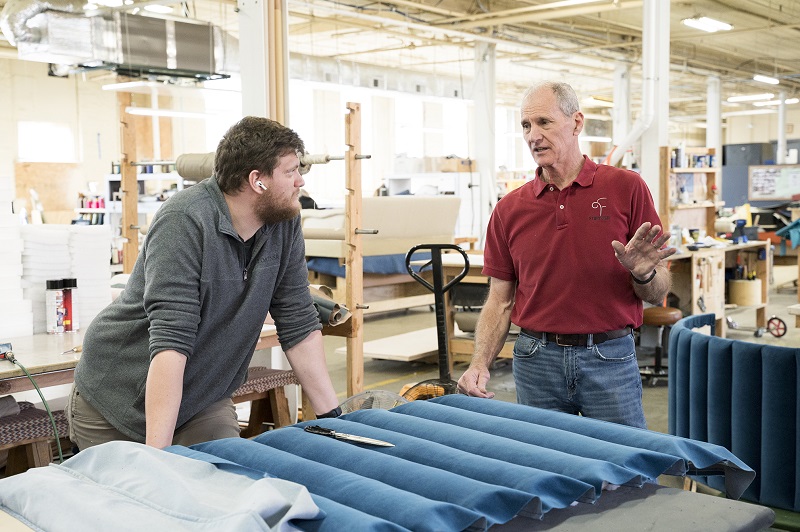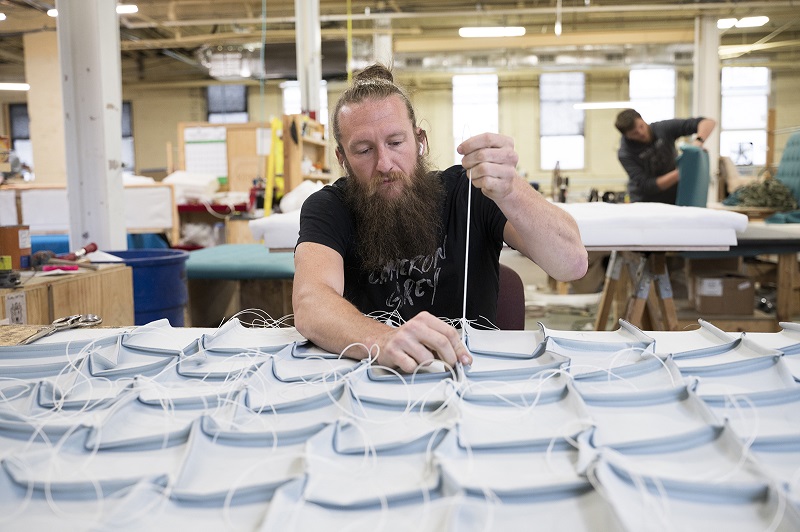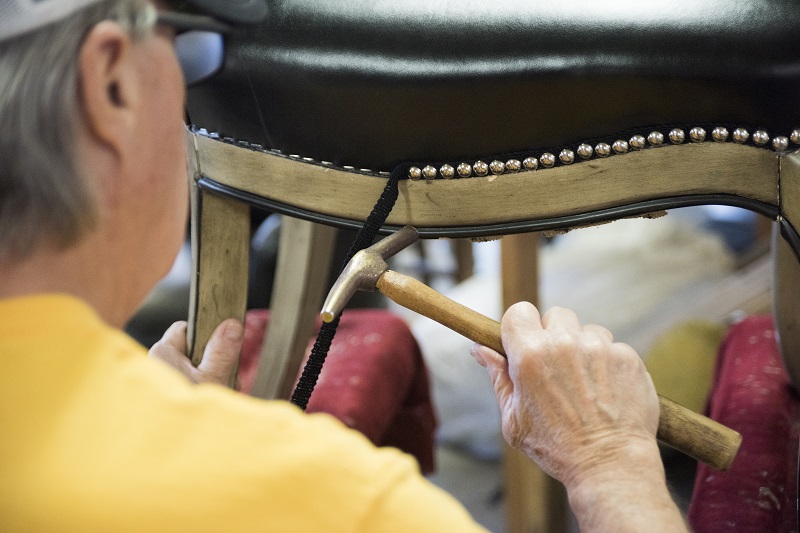By Monica Rhodes, NUA Volunteer and Owner of Monday Wash Furniture
An Interview with Glenn McAllister of Fortner Inc. on expanding and hiring within the evolving landscape of upholstery service, training and employment.
Right now, upholstery is like a bag of chips we just keep shaking for a few more crumbs. – Cynthia Bleskachek, Master Upholsterer, Upholstery Educator, and Creator of the Funky Little Chair Upholstery Education Systems, on Instagram 8/28/22
Once upon a time, that bag of chips was full. Back in the day, “reupholstering furniture was the norm,” explains Glenn McAllister, Project Manager at Fortner, Inc. in Columbus, Ohio. “Then the influx of furniture from overseas changed the landscape.”
David Fortner began his upholstery business nearly 100 years ago, going from door to door to offer his services. David, who was unable to hear, taught his son, David Fortner, Jr., the art of upholstery and the two worked side-by-side in their garage with David Jr. serving as the “mouthpiece” for the business. The elder David was otherwise employed, at first, and the younger still in school, but it was soon clear that there was sufficient demand for the pair to take on upholstery full-time. Today, Fortner, Inc., which remains a family owned and run business, thrives as one of the largest upholstery operations in the State of Ohio. Housed in a 60,000 square foot space in a 240,000 square foot complex dubbed “The Fort”, Fortner, Inc. employs “a team of master craftsmen to build and upholster pieces the old-fashioned way” honoring the “same core values since day one”: real furniture, good people, and focus on the client. Fortner’s website details the above and proudly declares the following: "While we’ve evolved throughout the years and now serve some of the biggest names in business across the country alongside our residential clients, one thing hasn’t changed: We’re still family-owned and -operated - guided by the vision of David (Sr.)’s great grandchildren."
 For Glenn McAllister, Project Manager at Fortner, joining the family and joining the business went hand- in-hand. Glenn began dating David Jr.’s oldest daughter, Sharon, in high school and it wasn’t long before he started doing deliveries. He continued to help out around the shop through college, eventually apprenticing under his soon-to-be father-in-law and developing a lasting love for upholstery work as well for Sharon and her family. When Glenn and Sharon became engaged, their discussion about the future naturally included staying with the business. Their son, Justin, became an upholsterer and now owns the company as well as the building complex which “leases iconic spaces to organizations of all sizes and specialities, from creative studios and local start-ups to retail businesses and large-scale manufacturing.” Glenn’s and Sharon’s daughter, Monica, oversees business development. And, on any given day, you are likely to find the couple’s grandchildren mowing the lawn around The Fort or tearing down in the shop.
For Glenn McAllister, Project Manager at Fortner, joining the family and joining the business went hand- in-hand. Glenn began dating David Jr.’s oldest daughter, Sharon, in high school and it wasn’t long before he started doing deliveries. He continued to help out around the shop through college, eventually apprenticing under his soon-to-be father-in-law and developing a lasting love for upholstery work as well for Sharon and her family. When Glenn and Sharon became engaged, their discussion about the future naturally included staying with the business. Their son, Justin, became an upholsterer and now owns the company as well as the building complex which “leases iconic spaces to organizations of all sizes and specialities, from creative studios and local start-ups to retail businesses and large-scale manufacturing.” Glenn’s and Sharon’s daughter, Monica, oversees business development. And, on any given day, you are likely to find the couple’s grandchildren mowing the lawn around The Fort or tearing down in the shop.
Fortner Inc. employs 41 people, just about half of whom have some degree of skill in upholstery and all of whom are considered part of “the family”. Staff retention is high with several employees in their third or fourth decade of employment, a few of them approaching retirement and leaving shoes to fill. Filling those shoes can be a bit of a challenge. Just as reupholstering was once the norm for consumers, the apprenticeship model was once the norm for education and succession within the trade. One became an upholsterer through years of intensive on-the-job training and then taught others in the same manner. There was high demand for reupholstery and, therefore, for skilled upholsterers - and there was supply. The bag of chips was full.
 But things change. Cultural, societal and economic norms shift. Expectations regarding education and the definition of success shift. People want things and they want them now. People move from job to job, sometimes a dozen jobs in a lifetime, and move often. Moving furniture starts to feel cumbersome. It seems to make more sense to purchase transient furniture. To discard it and start over when you move. To discard it and buy more when you want a change. Heirloom furniture gives way to “fast furniture” largely manufactured and shipped from overseas. Our landfills rise as expectations and demands regarding quality fall. Welcome to the new normal.
But things change. Cultural, societal and economic norms shift. Expectations regarding education and the definition of success shift. People want things and they want them now. People move from job to job, sometimes a dozen jobs in a lifetime, and move often. Moving furniture starts to feel cumbersome. It seems to make more sense to purchase transient furniture. To discard it and start over when you move. To discard it and buy more when you want a change. Heirloom furniture gives way to “fast furniture” largely manufactured and shipped from overseas. Our landfills rise as expectations and demands regarding quality fall. Welcome to the new normal.
Within the new normal, the traditional apprentice model is adrift and possibly drowning. In past decades, without the benefit of formal training academies (such as exist in Europe), upholsterers in the United States learned the craft by apprenticing in shops. While demand for reupholstery was strong and steady, shops could support this model. As demand for reupholstery services declined over the years, many upholsterers aged out without successors and shuttered their businesses. Then, the pendulum swung and demand began to increase again for reasons ranging from a reemerging longing for quality to concerns about environmental sustainability. (Recently, the Covid-19 lockdowns gave that pendulum an extra shove as so many people reconsidered their living spaces.) As a result of these shifts, the upholstery shops that remain are fewer and farther between: some struggling to stay afloat, some (particularly solo enterprises) overwhelmed by the demands of the now increasing number of consumers who value and desire reupholstery services, some pivoting to new business models – and many encountering real challenges to making the apprenticeship model work. Apprenticing new employees is seriously time and resource intensive. It may feel like an unwise choice, or even an impossible burden. So how are these shops to adapt and stay viable? To grow? To continue through the next generation?
 Fortner, Inc. is among the shops that have pivoted and adapted with great success. As reliance on residential reupholstery became less and less sustainable, Fortner started reaching out to corporations, hospitality, etc. “That resulted in a pretty big stream of business,” says Glenn McAllister who describes business at Fortner as “a three-legged stool” comprising traditional reupholstery, custom upholstery of new pieces, and production upholstery/reupholstery. “Commercial custom (for example, producing dozens of the same item over and over again for corporate spaces) is the real bread and butter now,” he says. “Reupholstery is about 25% of what we do currently, and the rest is commercial and custom.” This shift has necessitated an increase in new hires to accommodate production requirements. At the same time, the reupholstery staff is aging. “I would love to have two more quality upholsterers to support, and eventually replace, our older upholsterers,” says Glenn.
Fortner, Inc. is among the shops that have pivoted and adapted with great success. As reliance on residential reupholstery became less and less sustainable, Fortner started reaching out to corporations, hospitality, etc. “That resulted in a pretty big stream of business,” says Glenn McAllister who describes business at Fortner as “a three-legged stool” comprising traditional reupholstery, custom upholstery of new pieces, and production upholstery/reupholstery. “Commercial custom (for example, producing dozens of the same item over and over again for corporate spaces) is the real bread and butter now,” he says. “Reupholstery is about 25% of what we do currently, and the rest is commercial and custom.” This shift has necessitated an increase in new hires to accommodate production requirements. At the same time, the reupholstery staff is aging. “I would love to have two more quality upholsterers to support, and eventually replace, our older upholsterers,” says Glenn.
Fortner has employed the apprenticeship model to meet this need with varying results. The shop is divided into three sections, one for each of the legs of the three-legged stool. “Production does 50-75 pieces at a time for casinos, restaurants, etc. and requires a more limited skill level,” says Glenn. “We’re constantly working with what we’ve got so, occasionally, if we have an emergency, we may move someone over from production and teach them what we need them to do in reupholstery.” This is accomplished through one-on-one mentorship. It’s difficult to anticipate emergencies, so “we put together an apprenticeship program five or so years ago with one upholsterer who was willing to teach four men from the production side.” Of the 4 starters, only 2 became members of the team. “It’s difficult to identify the right teacher and the right students and it’s very time intensive and costly,” Glenn explains. The teacher sacrifices time otherwise dedicated to upholstery work to accommodate the instruction schedule, and there’s no guarantee it will pay off.
 A more successful approach, for Fortner, has been to hire a recruiter who scours the country to identify and entice already skilled upholsterers to relocate to Columbus, OH. “We’re looking for more than an upholsterer, we’re looking for a good fit,” says Glenn. Every member of the team is unique and brings something to the table. Last year, the recruiter found someone in Florida who had a lot of experience in custom within the yachting industry who was looking to move.” The recruiter also identified a husband-and-wife upholstery team who wished to relocate from North Carolina. “It turns out they have a son who may want to come out and work for us as well,” says Glenn. “There’s always room for another set of skilled hands.”
A more successful approach, for Fortner, has been to hire a recruiter who scours the country to identify and entice already skilled upholsterers to relocate to Columbus, OH. “We’re looking for more than an upholsterer, we’re looking for a good fit,” says Glenn. Every member of the team is unique and brings something to the table. Last year, the recruiter found someone in Florida who had a lot of experience in custom within the yachting industry who was looking to move.” The recruiter also identified a husband-and-wife upholstery team who wished to relocate from North Carolina. “It turns out they have a son who may want to come out and work for us as well,” says Glenn. “There’s always room for another set of skilled hands.”
When asked what is needed to support growth and development of businesses like Fortner, Inc., Glenn McAllister points to creating and strengthening connections amongst upholsterers in different geographic locations. Indeed, linkages amongst dispersed members of the upholstering community are key in today’s world and are a source of hope for the future in terms of both education and employment. There are, in fact, quite a few people working as, or training in various ways to become, upholsterers in the United States now. Many of these are “solopreneurs” who have scoured books and the internet, sought out mentors, observed webinars, taken classes when and where they could find them, and practiced, practiced, practiced to the point of achieving success. More and more, these successful entrepreneurs are reaching out to teach not only “newbies”, but also one another, as a gesture of support as well as a revenue generating aspect of their business models.
Cynthia Bleskachek (quoted above), who is a founding member of the National Upholstery Association, has striven mightily to develop and realize her vision of an apprenticeship network that works in today’s environment. As part of this endeavor, she has created incredibly organized and well-supported training systems (including detailed written and video support materials and one-on-one coaching from instructors) that have been implemented via the internet, and in person. Kim and Bill Chagnon, of Kim’s Upholstery Education, have created and implemented an upholstery education membership group through which those seeking to learn can avail themselves of myriad instructional videos and receive direct support and advice via Zoom and community forums, as well as participate in workshops hosted around the country. Talented solo upholsterers like Rhonda Shanahan (The Whimsical Chair), Nancy Sargent (Cobani Bleu) and Claire Wright (Cosecha Textiles) are teaching in their own shops and/or in host shops across the country. Additionally, some upholsterers are forming/joining business support and accountability groups through which they share knowledge and expertise with one another on a variety of levels. (I am fortunate to belong to an excellent group led by Michelle Minner of Blue Roof Cabin.) The landscape has changed, but it has certainly not gone fallow; It is actually quite robust and, little-by-little, coalescing to form a new normal that is, perhaps, not so bad.
“People are connected and working together,” notes Cynthia Bleskachek in a follow up post on Instagram (8/28/22). “…upholsterers were historically difficult to find and even harder to engage. Not anymore – they are linked and discoverable, a far more fertile landscape for change to take root.” The National Upholstery Association has proven to be an invaluable resource for facilitating such linkages. And I can certainly envision a scenario in which shop owners currently stretched too thin to apprentice new employees might be able to make that leap by incorporating some of the incredible training resources that have emerged recently, including those mentioned above. Today’s upholstery community is shaking things up - and those crumbs that have shaken out just may form a trail that can be followed. A new, as yet emerging, path of training leading to employability that prepares budding upholsterers to join the trade through multiple linkages with more established upholsterers, including enthusiastic educators - and excellent shops eager to hire, like Fortner Inc. in Columbus, Ohio.
Wouldn’t that be all that and a bag of chips?
Fortner, Inc. Recruiting Video: https://www.youtube.com/watch?v=lWEMff-n6Nk
Website: www.fortnerinc.com